英语词汇学复习要点(不过就难啊)
英语词汇学怎么考 英语词汇学必背知识点
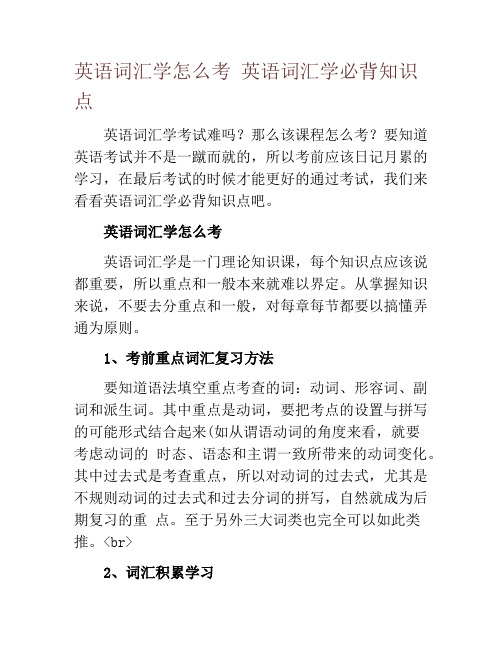
英语词汇学怎么考英语词汇学必背知识点英语词汇学考试难吗?那么该课程怎么考?要知道英语考试并不是一蹴而就的,所以考前应该日记月累的学习,在最后考试的时候才能更好的通过考试,我们来看看英语词汇学必背知识点吧。
英语词汇学怎么考英语词汇学是一门理论知识课,每个知识点应该说都重要,所以重点和一般本来就难以界定。
从掌握知识来说,不要去分重点和一般,对每章每节都要以搞懂弄通为原则。
1、考前重点词汇复习方法要知道语法填空重点考查的词:动词、形容词、副词和派生词。
其中重点是动词,要把考点的设置与拼写的可能形式结合起来(如从谓语动词的角度来看,就要考虑动词的时态、语态和主谓一致所带来的动词变化。
其中过去式是考查重点,所以对动词的过去式,尤其是不规则动词的过去式和过去分词的拼写,自然就成为后期复习的重点。
至于另外三大词类也完全可以如此类推。
<br>2、词汇积累学习加强短文背诵,增强“词不离句”意识。
背诵是非常原始的英语学习方法,但也是非常积极、有效的学习方法。
优选一些名家名篇,做为背诵的素材;或从课文中精选一些精悍之作,作为研习的精典,不但能够迅速提高语感,而且容易激发兴趣,形成活生生的词库,为单词的准确使用打下良好的基础。
3、英语主观题拿分技巧首先是单词拼写,这是所有题目中考生得分最低的一个部分,通常平均分不超过3分,所以大家不要太在意,20个单词,对4个,能有2分就很不错了,如果想要提高这部分,大家还要有准备的背单词,因为这里面的单词,并不全是课本课后单词表的单词,其中很多都是以前在中学学过的,所以要准备这一部分,需要的是买一本自考英语的词汇大纲,按里面的词汇背记才有意义。
如果大家对英语词汇学课程学习有难度,那么可以通过在线视频学习的,以上三点就是学赛小编对英语词汇学必背知识点学习方法,希望大家能更好的学习。
点击进入>>>。
英语词汇学考试重点整理
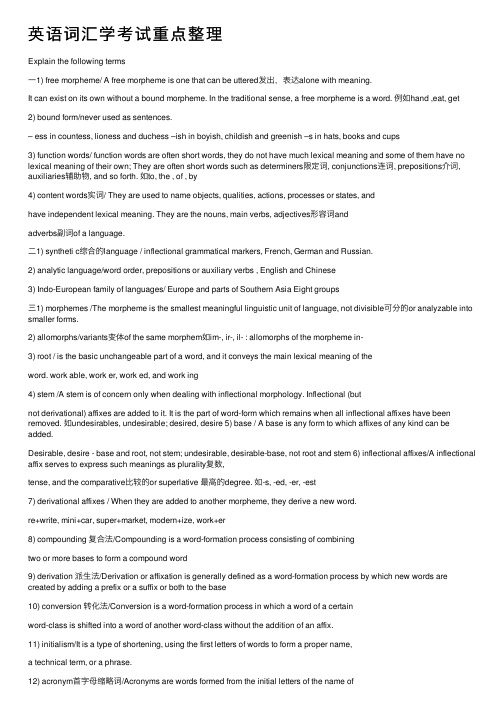
英语词汇学考试重点整理Explain the following terms⼀1) free morpheme/ A free morpheme is one that can be uttered发出,表达alone with meaning.It can exist on its own without a bound morpheme. In the traditional sense, a free morpheme is a word. 例如hand ,eat, get 2) bound form/never used as sentences.– ess in countess, lioness and duchess –ish in boyish, childish and greenish –s in hats, books and cups3) function words/ function words are often short words, they do not have much lexical meaning and some of them have no lexical meaning of their own; They are often short words such as determiners限定词, conjunctions连词, prepositions介词, auxiliaries辅助物, and so forth. 如to, the , of , by4) content words实词/ They are used to name objects, qualities, actions, processes or states, andhave independent lexical meaning. They are the nouns, main verbs, adjectives形容词andadverbs副词of a language.⼆1) syntheti c综合的language / inflectional grammatical markers, French, German and Russian.2) analytic language/word order, prepositions or auxiliary verbs , English and Chinese3) Indo-European family of languages/ Europe and parts of Southern Asia Eight groups三1) morphemes /The morpheme is the smallest meaningful linguistic unit of language, not divisible可分的or analyzable into smaller forms.2) allomorphs/variants变体of the same morphem如im-, ir-, il- : allomorphs of the morpheme in-3) root / is the basic unchangeable part of a word, and it conveys the main lexical meaning of theword. work able, work er, work ed, and work ing4) stem /A stem is of concern only when dealing with inflectional morphology. Inflectional (butnot derivational) affixes are added to it. It is the part of word-form which remains when all inflectional affixes have been removed. 如undesirables, undesirable; desired, desire 5) base / A base is any form to which affixes of any kind can be added.Desirable, desire - base and root, not stem; undesirable, desirable-base, not root and stem 6) inflectional affixes/A inflectional affix serves to express such meanings as plurality复数,tense, and the comparative⽐较的or superlative 最⾼的degree. 如-s, -ed, -er, -est7) derivational affixes / When they are added to another morpheme, they derive a new word.re+write, mini+car, super+market, modern+ize, work+er8) compounding 复合法/Compounding is a word-formation process consisting of combiningtwo or more bases to form a compound word9) derivation 派⽣法/Derivation or affixation is generally defined as a word-formation process by which new words are created by adding a prefix or a suffix or both to the base10) conversion 转化法/Conversion is a word-formation process in which a word of a certainword-class is shifted into a word of another word-class without the addition of an affix.11) initialism/It is a type of shortening, using the first letters of words to form a proper name,a technical term, or a phrase.12) acronym⾸字母缩略词/Acronyms are words formed from the initial letters of the name ofan organization or a scientific term, etc. Acronyms differ from initialisms in that theyare pronounced as words rather than as sequences of letters.13) blending拼缀/Blending is a process of word-formation in which a new word is formed bycombining the meanings and sounds of two words, one of which is not in its full form or both of which are not in their full forms.14) clipping截短词/The process of clipping involves the deletion of one or more syllablesfrom a word (usually a noun), which is also available in its full form.15) back-formation逆⽣法/Back-formation is a term used to refer to a type of word-formationby which a shorter word is coined by the deletion of a supposed affix from a longerform already present in the language.四meaning /is the thing or idea that it refers to or represents and which can be explained using other words. conventionality/most words are conventional, arbitrary symbols; consequently, there is no intrinsic relation between the sound-symbol and its sense.motivation 理据/The connection between word symbol and its sense.grammatical meaning / Grammatical meaning consists of word-class and inflectional paradigm.World-class: it describes the word’s lexical meaning and also gives what is traditionally known as thepart of speech of the word, which modern linguists.lexical meaning /Lexical meaning is dominant in content words, whereas grammatical meaning is dominant in function words, but in neither is grammatical meaning absent.denotative meaning指⽰意义/is sometimes called the conceptual meaning. It is the central factor in linguistic communication. One of the functions of words is to designate or describesomething, such as an object, a property, a process or a state of affairs. Users of alanguage cannot talk about their knowledge of a physical object or a naturalphenomenon, unless this knowledge is express in words which have the same meaningfor all speakers of a given community.connotative meaning内涵意义/ refers to the emotional association which a word or a phrase suggests in one’s mind;it is the supplementary value which is added to the purelydenotative meaning of a word.stylistic meaning 社会意义/ What a word conveys about the social circumstances of its use affective meaning/ It is concerned with the expression of feelings and attitudes of thespeaker or writer.五1) Polysemy⼀词多义/Polysemy refers to a lexical term which has a range of different meanings.2) Homonymy同形异义/Pairs or groups of words, which, though different in meaning, arepronounced alike, or spelled alike, or both六restriction of meaning词义的缩⼩/A word of wide meaning acquires a narrower, specialized sense which is applicable合适的to only one of the objects it had previously以前denoted表⽰. extension of meaning词义的扩⼤/- the opposite of restriction- the widening of a word’s sense until it covers much more than what it originally conveyed. degeneration of meaning词义的降格/the meaning of a word narrows toward an unfavorable meaning elevation of meaning词义的升格/- A word meaning takes a turn for the better in the course of time, and has either risen from a “snarl”word to a “purr”word, or from a slang term to a common word.七linguistic context 语⾔语境/In a narrow sense, it refers to the words, clauses, sentences in which a word appears. This is known as linguistic context which may cover a paragraph, a whole chapter and even the entire book.extra-linguistic context⾮语⾔语境/In a broad sense, it includes the physical situation. This iscalled extra-linguistic or non-linguistic context, which embraces包含the people, time, place, and even the whole cultural background.the actual speech situation and the entire cultural background⼋complete synonyms/ Complete synonyms are the words which are fully identical in meaning and interchangeable in any context without the slightest alteration in connotative, affective and stylistic meanings.Scientific terms: delimited and neutral in affective情感的and stylistic meaning.relative synonyms /- the same denotative外延的meanings, but different connotative内涵的, affective and stylistic meanings contrary/gradable antonyms / They display a type of semantic contrast. They don’t represent an either/or relation but rather a more/less relation.cheap and expensive; fast and slow; sweet and sourcomplementary antonyms / They represent a type of binary semantic opposition. They are in an either/or relation of oppositeness. alive and dead; asleep and awake; shut and open converse antonyms /They are also called relational opposites. One expresses the converse meaning of the other. lend and borrow; buy and sell; husband and wife; parent and child; hyponym 下义词/Hyponymy deals with the relationship of semantic inclusion. That is, the meaning of a more specific word is included in that of another more general word.semantic field/The vocabulary of a language is not an unstructured collection of words. Instead, the vocabulary can be organized into a number of semantic fields.field of colours:pink, orange, scarlet, crimson, violet九Allusive words /words that are closely related to cultural history.Allusions : references参照to characters or events from history, legend, literature, religion.⼗idiom 习语/Idioms are usually metaphorical⽐喻性的rather than literal⽂字的.Structural criteria: phrase idioms; clause idioms; sentence idiomscollocation / Collocation is the way in which words are used together regularlyCollocation is often language-specific (e.g. “blue blood”)and not determined by universal semantic constrains (e.g. “green grass”).Answer the following questions⼀1) What are the fundamental features of the basic word stock of the English vocabulary?a. National characterb. Stability- sun, earth, rain, snow , on, of, can, will- arrow and bow ; telephone, computer, bus, car,radio, electricityc. Word-forming abilityheadache, headless不在意的;⽆头脑的;⽆领导者的, headline⼤标题;内容提要, headman⾸领, headmaster d. Ability to form collocations搭配hand over fist; hand in glove互相勾结、关系密切; to come hat in hand;2) How can we classify English vocabulary according to its origin, level of usage and notion ?⼆1) How do linguists divide the history of the English language for analysis? What are the characteristics of the English vocabulary as a result of its historical development?Three periods in the development of English language (vocabulary)1) Old English or Anglo-Saxon period (449-1100) 1 Much of the old English vocabulary was borrowed from Latin 如bargain, cheap, inch, pound; cup, dish, wall, wine, etc2- Old English was a highly inflected language. It has a complete system of declensions of words2) Middle English period ( 1100-1500 ) 1- French influence Norman Conquest in 1066 Law and government administration:、Military affairs: 、Religion: 、Art。
英语词汇学知识点整理
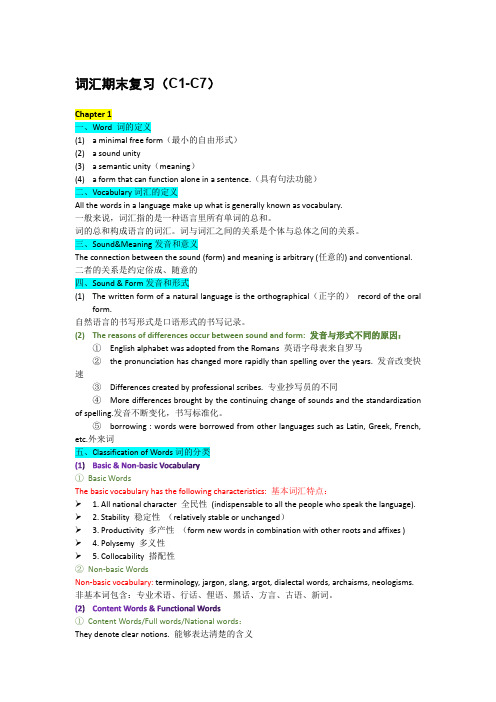
词汇期末复习(C1-C7)Chapter 1一、Word 词的定义(1) a minimal free form(最小的自由形式)(2) a sound unity(3) a semantic unity(meaning)(4) a form that can function alone in a sentence.(具有句法功能)二、Vocabulary词汇的定义All the words in a language make up what is generally known as vocabulary.一般来说,词汇指的是一种语言里所有单词的总和。
词的总和构成语言的词汇。
词与词汇之间的关系是个体与总体之间的关系。
三、Sound&Meaning发音和意义The connection between the sound (form) and meaning is arbitrary (任意的) and conventional. 二者的关系是约定俗成、随意的四、Sound & Form发音和形式(1)The written form of a natural language is the orthographical(正字的)record of the oralform.自然语言的书写形式是口语形式的书写记录。
(2)The reasons of differences occur between sound and form: 发音与形式不同的原因:①English alphabet was adopted from the Romans 英语字母表来自罗马②the pronunciation has changed more rapidly than spelling over the years. 发音改变快速③Differences created by professional scribes. 专业抄写员的不同④More differences brought by the continuing change of sounds and the standardization of spelling.发音不断变化,书写标准化。
英语词汇学总结复习资料

英语词汇学总结复习资料⼤家请注意:笔记中⼤多数是以名词解释的形式出现的,这些是绝对的基础,应该⼀字不漏的背下来。
其实不少简答题也就是⼏个定义的汇总,再加上个例⼦就可以拿满分了。
区分两个词的区别,主要还是指明其各⾃的定义。
第⼀章Basic Concepts of Words and Vocabulary1. 词的定义Word —— A word is a minimal free form of a language that has a given sound and meaning and syntactic function.2.声⾳与意义的关系There is no logical relationship between sound and meaning as the symbolic connection between them is arbitrary and conventional.E.g. ―woman‖ means ’Frau’ in German,’Femme’ in French and ’Funv ’in Chinese. On the other hand,the same sound /rait/ can mean right,rite and write,though denoting different things,yet have the same sound.3.读⾳与拼写不⼀致的原因The difference between sound and form result from 4 major factors.(At least 80%of the English words fit consistent spelling patterns)a). the internal reason is English alphabet does not have a separate letter to represent each sound in the language.b). Pronunciation has changed more rapidly than spellingc). Influence of the work of scribes/printing freezes the spelling of words in 1500d). Borrowing of foreign language4. 词汇的含义Vocabulary —— Vocabulary is most commonly used to refer to the sum total of all the words of a language. It can also refer to all the words of a given dialect,a given book,a given displine and all the words possessed by an individual person as well as all the words current in a particular period of time in history.The general estimate of the present day English vocabulary is over 1 million words.5.词汇的分类的原则Classification of Words—by use frequency,by notion,by originthe English vocabulary consist of words of all kinds. they can be classified by different criteria and for different purpose . words may fall into the word stock and nonbasic vocabulary by use frequency, into content words and functional words by notion , and into native words and borrowed words by origin.基本词汇的特点1). Basic word stock – the foundation of the vocabulary.1.all national character (most important)– natural phenomenamost common things and phenomena of the human body and relationsworld around us names of plants and animals action,size,domain,state numerals,pronouns,prep. ,conj.2. stability– they donate the commonest thing necessary to life,they are like to remain unchanged. Only relative,some are undergoing some changes. But the change is slow.e.g. arrow,bow,chariot,knight – past electricity,machine,car,plane ——now3.productivity– they are mostly root words or monosyllabic words,they can form new words with other roots and affixes.e.g. foot – football,footage,footpath,footer4.polysemy – often possess more than one meaning. Become polysemous.e.g. take to move or carry from one place to another to remove5.collocability– quite a number of set expressions,idiomatic usages,proverbial saying and others基本词汇在英语中的地位和重要性The basic word stock is the foundation of the vocabulary accumulated over centuries and forms the common core of thelanguage .though words of the basic word stock constitute a small percentage of the English vocabulary ,yet it is the most important part of it .e.g. heart – a change of heart, a heart of goldNon-basic vocabulary ——(例⼦)1. terminology –technical terms used in particular disciplines and academic areas as in medicinephotoscanning,hepatitis,indigestion,penicillin,algebra,trigonometry,calculus2. jargon– specialized vocabulary in certain professions.Bottom line,ballpark figures,bargaining chips,hold him back,hold him in,paranoid3. slang—— substandard words often used in informal occasionsdough and bread,grass and pot,beaver,smoky,bear,catch,holler,Roger,X-rays,Certain words are labeled slang because of their usage.4. argot – words used by sub-cultured groupscan-opener,dip,persuader cant,jargon ,argot are associated with,or most available to,specific groups of the population.5. dialectal words– only by speakers of the dialectbeauty,chook,cocky,station,auld,build,coo,hame,lough,bog6. archaisms – words no longer in common use or restricted in use. In older poems,legal document and religious writing or speech.7. neologism– newly created words with new meaning e.g. microelectronics,futurology,AIDS,internet,E-mailold meaning acquired new meaning e.g. mouse,monitor2). Content word (notional word)– denote clear notions.Functional word (empty word,form word)– do not have notions of their own,express the relation betweennotions,words and sentences.a. Content words constitute the main body of the English vocabulary are numerous.Functional words are in a small number.b. Content words are growing.Functional words remain stable.c. Functional words do far more work of expression than content words.3). Native words –are words brought to Britain in the 15 century by the German tribes. Ango-Saxon Words,50,000-60,000What is true of the basic word stock is also true of native world. More are1. neutral in style (not stylistical specific )2. 2.frequent in use (in academic fields and science French,Latin or Greek are used)(usage 70-90%)Borrowed words (loan words,borrowing)– words taken over from foreign language. 80%本族语词在英语中的地位和重要性Native words form the mainstream of the basic word stock and stand at the core of the language .therefore , what is true of the basic word stock is also true of native words.According to the degree of assimilation and manner of borrowing,we can bring the loan words under 4 classes.1.Denizen s– words borrowed early and now are well assimilated into English language.e.g. port from portus(L)shift,change,shirt,pork cup from cuppa(L)2.Aliens– retained their original pronunciation and spellinge.g. décor(F)blitzkreeg(G)emir,intermez,rowtow,bazaar,rajar,status quo3.translation loans– formed from the existing material in the English language but modeled on the patterns taken from another language.1). Word translated according to the meaninge.g. mother tough from lingua maternal(L)black humor from humor noir long time no see,surplus value,master piece 2). Words translated according to the sounde.g. kulak from kyrak(Russ)lama from lama(Tib)ketchup tea4. Semantic loans– their meaning are borrowed from another languagee.g. stupid old dump new sassy dream old joy and peace pioneer old explorer/person doing pioneering work new a member of the young pioneer fresh old impertinent,sassy,cheeky第⼆章The Development of the English1、Indo-European language family (Europe,the Near East,India)It can be grouped into an Eastern set :Balto –Slavic 、Indo-Iranian、Armenian and Albanian; a Western set: Celtic、Italic 、Hellenic、GermanicIn the Eastern set , Armenian and Albanian are each the only modern language respectively,the Balto –Slavic comprises such modern language such as Prussian、Lithuanian、Polish、Czech、Bulgarian、Slovenian、Russian. In the Indo-Iranian we have Persian, Bengali, Hindi, Romany, the last three of which are derived from the dead language Sanskrit.In the Western set, Greek is the modern language derived from Hellenic. In the Celtic,we find Scottish, Irish,Welsh, Breton. the five Romance language ,namely, Portuguese,Spanish, French, Italian, Roumanian all belong to the Italic through an intermediate language called Latin. The Germanic family consist of the four Northern European language :Norwegian, Icelandic, Danish and Swedish, which are generally known as Scandinavian languages. Then there is German, Dutch, Flemish and English.2、History (时间,历史事件,特征)1)Old English (450-1150)totally 50,000-60,000 wordsThe 1st people known to inhabit England were Celts,the language was Celtic.The second language was the Latin of the Roman Legions. The Germanic tribes called angles,Saxons and Jutes and their language,Anglo-Saxon dominated and blotted out the Celtic. Now people refer to Anglo-Saxon as old English. At the end of 6th century,the introduction of Christianity has a great impact on the English vocabulary. The common practice was to create new words bycombining two native words. In the 9th century,many Scandinavian words came into English. At least 900 words of Scandinavian are in modern English,our daily life and speech.特点:highly inflected language///complex endings or vowel changes (full ending)2)Middle English (1150-1500)English,Latin,FrenchUntil 1066,although there were borrowings from Latin,the influence on English was mainly Germanic. But the Norman Conquest started a continual flow of French words into English.By the end of the 13th century,English gradually come back into public areas.Between 1250 and 150 about 9000 words of French origin pouered into English. 75% of them are till in use today.As many as 2500 words of Dutch origin come into English.特点:fewer inflections leveled ending3)Modern English (1500-up to now)early modern English (1500-1700)late modern English(1700-up to now)The Renaissance(the early period),Latin and Greek were recognized as the languages of the West ern world’s great literary heritage.From the 1500’s through the 1700’s ,many writers experimented with words. Over 10000 new words entered the English language .many of these were taken from Latin and Greek .The Industrial Revolution was in the mid-17 century. With the growth of colonization,British tentacles began a stretching out of to every corner of the globe,thus enabling English to absorb words from all major languages of the world.After World War II,many new words have been created to express new ideas,inventions and scientific achievements. More words are created by means of word-formation.thousands and thousands of new words have been entered to express new ideas inventions,and scientific achievements. more words are created by means of word-formation.in modern English,word endings were mostly lost with just a few exceptions English has evolved from a synthetic language to the present analytic language.science and technology terms make up about 45% of new words. words associated with life-style constitute of 24% and social and economic terms amount to over 10% .mention should be made of an opposite process of development i.e. old words falling out if use.特点:ending are almost lost.3. Three main sources new words当代英语词汇发展的现状New words sweep in at a rate much faster than at any other historical period of time .词汇发展的主要原因1).The rapid development of modern science and technology2).Social: economic and political changes3).The influence of other cultures and languages4. Three modes of vocabulary development(英语发展的三个主要⽅式:创造新词、旧词新意、借⽤外来语词)1. Creation – the formation of new words by using the existing materials,namely roots,affixes and other elements. (This is the most important way of vocabulary expansion.)2. Semantic change - an old form which take on a new meaning to meet the new need.3. Borrowing – to take in words from other languages.(played a vital role in the development of vocabulary , particularly in earlier times)4. (Reviving archaic or obsolete)French 30%,Latin 8%,Japanese Italian 7%,Spanish 6%,German Greek 5%,Russian Yiddish 4%第三章Word Formation*1. Morpheme(词素) ——A morpheme is the smallest meaningful unit of a language. (The smallest functional unit in the composition of words.)*2.Morph—— A morpheme must be realized by discrete units. These actual spoken minimal carriers of meaning are morphs.3.Monomorphenic words– morphemes are realized by single morphs.4.Allomorph(词素变体)——Some morphemes are realized by more than one morph according to their position. Such alternative morphs are allomorphemes. E.g. the morpheme of plurality (-s)has a number if allomorphemes in different sound context,e.g. in cats/s/,in bags/z/,in matches/iz/.5. Free morphemes or Free root —— The morphemes have complete meaning and van be used as free grammatical units in sentences,e.g. cat,walk. They are identical with root words. morphemes which are independent of other morphemes are considered to be free.6.Bound Morphemes——The morphemes cannot occur as separate words. They are bound to other morphemes to form words,e.g. recollection (re+collect+ion)collect – free morpheme re-and –ion are bound morphemes. (include bound root and affix)Bound morphemes are found in derived words.7.Bound root ——A bound root is that part of the word that carries the fundamental meaning just like a free root. Unlike a free root,it is a bound form and has to combine with other morphemes to make words. Take -dict- for example:it conveys the meaning of ―say or speak‖ as a Latin root,but not as a word. With the prefix pre-(=before)we obtain the verb predict meaning ―tell beforehand‖。
词汇学复习资料

词汇学复习资料词汇学复习资料词汇学是语言学的一个重要分支,研究词汇的构成、分类和使用规律。
对于学习一门语言来说,掌握丰富的词汇是非常重要的。
在这篇文章中,我们将提供一些词汇学的复习资料,帮助读者巩固和扩展词汇量。
一、词汇的构成词汇是语言的基本单位,是由一个或多个音素组成的。
在不同的语言中,词汇的构成方式也有所不同。
例如,英语中的词汇主要由字母组成,而汉语中的词汇则由汉字组成。
1. 字母构词法英语中的词汇通常由字母组成,可以通过添加前缀、后缀和词根来构成新的词汇。
例如,单词“unhappiness”由前缀“un-”(表示否定)和词根“happy”组成。
2. 字形构词法汉语中的词汇由汉字组成,可以通过添加偏旁部首、衍生字和合成字来构成新的词汇。
例如,汉字“学”可以通过添加偏旁部首“子”来构成“字”,表示学习。
二、词汇的分类词汇可以按照不同的分类标准进行分类,例如按照词性、语义和用途等。
下面是一些常见的词汇分类。
1. 词性分类词汇可以分为名词、动词、形容词、副词、代词、介词、连词和感叹词等不同的词性。
名词用来表示人、事物或概念,动词用来表示动作或状态,形容词用来描述人或事物的特征,副词用来修饰动词、形容词或其他副词,代词用来代替名词,介词用来表示位置、时间或方式,连词用来连接词语或句子,感叹词用来表示强烈的情感。
2. 语义分类词汇可以按照词义的相似性进行分类。
例如,可以将名词按照人、动物、植物、物体、抽象概念等进行分类;将动词按照行为、状态、感觉、思维等进行分类;将形容词按照颜色、大小、形状、性质等进行分类。
3. 用途分类词汇可以按照在句子中的作用进行分类。
例如,可以将词汇分为实词和虚词。
实词包括名词、动词、形容词和副词,它们在句子中起到实际的意义;虚词包括代词、介词、连词和感叹词,它们在句子中起到连接或修饰的作用。
三、词汇的使用规律词汇的使用规律是指在特定语境中使用词汇的约束条件。
不同的语言和不同的语境中,词汇的使用规律也有所不同。
2023年自考00832英语词汇学考试重点精华整理

English Lexicology(英语词汇学)1.English lexicology aims at investigating and studying the morphological structures of English words and word equivalents, their semantic structures, relations, historical development, formation and usages.英语词汇学意在调查和研究英语单词和单词旳等价物旳形态构造,其语义构造、关系、历史发展、形成和使用方法。
2.English Lexicology is correlated with such linguistic disciplines as morphology(形态学), semantics(语义学), etymology(词源学),stylistics(文体论)and lexicography(词典学) Chapter 1--Basic concepts of words and vocabulary1.Word(词旳定义): A word is a minimal free form of a language that has a given sound and meaning and syntactic function. (1)a minimal free form of a language (2)a sound unity (3)a unit of meaning (4)a form that can function alone in a sentence词语是语言最小旳自由形式,拥有固定旳声音和意义以及句法作用。
2.Sound and meaning(声音与意义): almost arbitrary, “no logical relationship between the sound which stands for a thing or an idea and the actual thing and idea itself”3.Sound and form(读音和形式):不统一旳四个原因(1)the English alphabet was adopted from the Romans,which does not have a separate letter to represent each other (2)the pronunciation has changed more rapidly than spelling over the years(3)some of the difference were created by the early scribes(4)the borrowings is an important channel of enriching the English vocabulary (5)printing、standardization、dictionary—Old English,The speech of the time was represented very much more faithfully in writing than itis today. 古代英语中旳口语比今天更忠实旳代表书面语—The written form of English is an imperfect representation of the spoken form。
英语词汇学知识点归纳总结

英语词汇学知识点归纳总结
1.词汇分类:英语词汇可以分为实词和虚词两大类。
实词包括名词、
动词、形容词和副词,是能独立存在并具有词义的词类;虚词包括冠词、
介词、连词、代词和助词,是不能独立存在或不具有词义的词类。
2.词根与词缀:英语词汇中有很多词根和词缀,词根是词的核心部分,词缀是附加在词根上的,可以改变词的词义、词性或词形。
3.词义:英语词汇的词义可以通过定义、同义词、反义词、上下义词
等方式进行描述和解释。
词义可以有直观意义、引申意义和隐喻意义等。
4.词汇建构:英语词汇的建构可以通过合成、派生、转化、缩略等方
式进行。
合成是通过将两个或多个词根组合成一个新词,派生是通过添加
前缀或后缀来构成新词,转化是通过改变词的词类来构成新词,缩略是通
过省略部分词组或词根来构成新词。
5.词汇变化:英语词汇的变化形式包括时态、语态、人称、数和比较等。
词汇的变化形式可以通过词形变化、语法变化和语义变化等方式进行。
6.外借词:英语词汇中存在大量的外借词,这些词汇主要来自拉丁语、希腊语、法语、德语等其他语言。
外借词在英语中经过适当的拼写、读音
和意义调整后被接受和使用。
7.同源词:英语词汇中存在一些同源词,这些词源于同一词根或词源,并在语音、形态或词义上有一定的相似性。
了解同源词可以帮助理解和记
忆词汇。
8.词汇扩展:英语词汇在发展的过程中会发生扩展,即一个词从最初的特定意义扩展到更广泛的意义。
词汇扩展可以通过引申、转义、隐喻等方式进行。
这些是英语词汇学中的一些主要知识点,通过对这些知识点的学习和理解,可以更好地掌握和应用英语词汇。
《英语词汇学》知识点归纳

English Lexicology(英语词汇学)Lexicology: is a branch of linguistics, inquiring into the origins and meanings of words.Chapter 1--Basic concepts of words and vocabularyWord: A word is a minimal free form of a language that has a given sound and meaning and syntactic function. (1)a minimal free form of a language (2)a sound unity (3)a unit of meaning (4)a form that can function alone in a sentenceSound and meaning: almost arbitrary, “no logical relationship between the sound which stands for a thing or an idea and the actual thing and idea itself”Sound and form:不统一的四个原因(1)the English alphabet was adopted from the Romans, which does not have a separate letter to represent each other(2)the pronunciation has changed more rapidly than spelling over the years(3)some of the difference were creates by the early scribes(4)the borrowings is an important channel of enriching the English vocabulary词汇Vocabulary: all the words in a language make up its vocabulary词语分类Classification of English Words:1.By use frequency: basic word stock & non basic vocabulary基本词汇的特征:1)All-National character(全民通用性most important)2)Stability3)Productivity(多产性) 4)Polysemy(多义性)5)Collocability(可搭配性)没有上述特征的词:(1)Terminology(术语) (2)Jargon(行话)(3)slang(俚语)(4)Argot(暗语)(5)Dialectal words (6)Archaisms(古语) (7) Neologisms(新词语):Neologisms2.By notion: content words实词 & functional words虚词3.By origin: native words & borrowed wordsNative words(本族语词): Two other features:(1)neutral in style (2)frequent in useBorrowed words/Loan words: words taken over from foreign languages.(80% of modern EV)1) denizens(同化词,融入英语): (shirt from skyrta(ON))2) aliens(非同化词/外来词,可以看出源头): kowtow3) translation loans(译借词):按其他语言方式组成英语long time no see / tofu4) semantic loans(借义词):they are not borrowed withreference to the form,but their meanings are borrowed pioneer本指开拓者,先引申为先锋。
词汇学知识点总结

词汇学知识点总结词汇学是语言学的一个重要分支,研究的是词汇的形成、结构和意义等方面的问题。
在学习英语等外语的过程中,词汇是其中一个重要的组成部分。
下面,本文将对词汇学的一些知识点进行总结与归纳。
一、词的形态学词的形态学是词汇学中必须掌握的一个重要方面,主要包括词的构词法、屈折变化和派生变化等。
词的构词法指的是如何通过组合原有的词来创造新词,包括派生法、合成法、缩略法、转化法等。
屈折变化指根据语法要求,变化词的形态以表示不同的格、时、数、性等。
派生变化则指通过在原有词基础上添加字母或词缀等来产生新的词。
掌握词的形态学是很有必要的,因为它和词汇的理解和使用密切相关。
二、词的分类在英语中,词可以根据其不同的语法特征被归为不同的类别,常见的类别包括名词、代词、动词、形容词、副词、介词、连词和感叹词等。
不同的词在句子中扮演着不同的角色,掌握各类别之间的区别以及它们在句子中的作用,可以帮助我们更好地理解和表达语言。
三、词义词义是从语言学的角度定义词的意义,包括原义和引申义。
原义指的是一个词最基本的意思,而引申义则是在原义基础上经过延伸、扩展而得到的新意义。
同一个词的不同意义和语言环境等也会导致其含义的变化,例如“bank”既可以表示银行,也可以表示河岸等。
在学习外语的过程中,掌握词义是十分重要的。
四、词汇的学习方法词汇的学习是英语学习中最基础也最重要的部分之一,因此选择适合自己的学习方法对于提高词汇量、扩大词汇面积至关重要。
常用的学习方法包括反复背诵、积累单词簿、整理词根词缀、阅读和听力等。
在学习方法上,以选择适合自己和有用的方法为主,同时注意与语言运用的联系,不断地推广和实践。
五、词汇的应用掌握了词汇学的知识和学习方法后,其实就迈出了学习英语的第一步。
在实际运用中,如何运用得当也是至关重要的环节。
为了提高语言的流利度,需要在口语和书面语两个方面加强实践,增强实际运用能力。
另外,可以较晚多在社交网络等平台上与外国人联系,使用所学的词汇,将知识应用到实际交流之中,效果更佳。
英语词汇学知识点整理

词汇期末复习(C1-C7)Chapter 1一、Word 词的定义(1) a minimal free form(最小的自由形式)(2) a sound unity(3) a semantic unity(meaning)(4) a form that can function alone in a sentence.(具有句法功能)二、Vocabulary词汇的定义All the words in a language make up what is generally known as vocabulary.一般来说,词汇指的是一种语言里所有单词的总和。
词的总和构成语言的词汇。
词与词汇之间的关系是个体与总体之间的关系。
三、Sound&Meaning发音和意义The connection between the sound (form) and meaning is arbitrary (任意的) and conventional. 二者的关系是约定俗成、随意的四、Sound & Form发音和形式(1)The written form of a natural language is the orthographical(正字的)record of the oralform.自然语言的书写形式是口语形式的书写记录。
(2)The reasons of differences occur between sound and form: 发音与形式不同的原因:①English alphabet was adopted from the Romans 英语字母表来自罗马②the pronunciation has changed more rapidly than spelling over the years. 发音改变快速③Differences created by professional scribes. 专业抄写员的不同④More differences brought by the continuing change of sounds and the standardization of spelling.发音不断变化,书写标准化。
英语词汇学知识点归纳
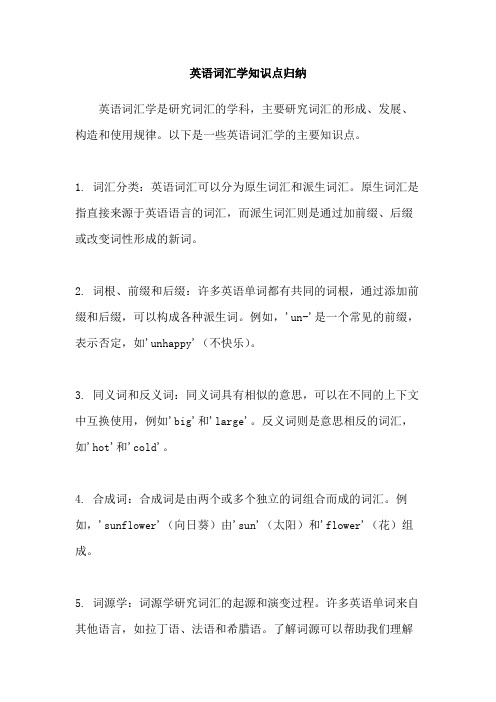
英语词汇学知识点归纳英语词汇学是研究词汇的学科,主要研究词汇的形成、发展、构造和使用规律。
以下是一些英语词汇学的主要知识点。
1. 词汇分类:英语词汇可以分为原生词汇和派生词汇。
原生词汇是指直接来源于英语语言的词汇,而派生词汇则是通过加前缀、后缀或改变词性形成的新词。
2. 词根、前缀和后缀:许多英语单词都有共同的词根,通过添加前缀和后缀,可以构成各种派生词。
例如,'un-'是一个常见的前缀,表示否定,如'unhappy'(不快乐)。
3. 同义词和反义词:同义词具有相似的意思,可以在不同的上下文中互换使用,例如'big'和'large'。
反义词则是意思相反的词汇,如'hot'和'cold'。
4. 合成词:合成词是由两个或多个独立的词组合而成的词汇。
例如,'sunflower'(向日葵)由'sun'(太阳)和'flower'(花)组成。
5. 词源学:词源学研究词汇的起源和演变过程。
许多英语单词来自其他语言,如拉丁语、法语和希腊语。
了解词源可以帮助我们理解词汇的含义和用法。
6. 词义的变化:词汇的意义会随时间和语境的变化而变化。
一些词汇可能会产生新的意义或失去原有的意义。
例如,'mouse'(老鼠)最初是指一种小动物,现在也可以指计算机的输入设备。
7. 词汇的语法功能:词汇在句子中扮演不同的语法角色,如名词、动词、形容词等。
了解词汇的语法功能可以帮助我们正确使用它们。
8. 语义关系:词汇之间存在各种语义关系,如同义关系、反义关系、上下位关系等。
了解这些关系可以帮助我们扩展词汇量,提高语言表达能力。
9. 词汇的习得和记忆:习得和记忆词汇是学习英语的重要一部分。
采用合适的记忆方法,如使用词汇卡片、词汇表等,可以帮助我们更好地掌握词汇。
以上是英语词汇学的一些主要知识点。
英语-《英语词汇学 》复习资料

《英语词汇学》复习资料1Ⅰ. Fill in the blanks.Directions: Complete the following statements with proper words.1.The 1 is the smallest functioning unit in the composition of words.2. 2 are words borrowed early in the past and now are well assimilated into the Englishlanguage.3.The problem of interrelation of the various meanings of the same word can be dealt with fromtwo different angles: 3 approach and synchronic approach.4.“Mal-” in “maltreat” is a 4 prefix, while “inter-” in “ interstate” is a 5 prefix.5.Old English is described as a language of full endings, Middle English language of 6endings, and a language of 7 endings.6.In modern English, one may find some 8 words whose sounds suggest their meaning,for these words were created by imitating the natural sounds or noises.7.The word meaning is made up of 9 meaning and 10 meaning, and the later hastwo components: conceptual meaning and 11 meaning.8.Words that have emotive values may fall into two categories: appreciative or 12 .9.13 is thought to be the opposite process of suffixation.10.14 is the formation of new words by combining parts of two words or a word plus apart of another word.11.15 refers to the jargon of criminals. Its use is confined to the sub-cultural groups, andoutsiders can hardly understand it.12.“Pretty” and “handsome” share the same 16 meaning,but differ in 17 meaning.13.___18___analysis is a process of breaking down the sense of a word into its minimalcomponents which are also known as semantic features..14.Radiation and 19 are the two coinages which the development of word meaningfollows from monosemy to polysemy.15.20 deals with the relationship of inclusion, i.e. the meaning of a more specific word isincluded in that of another more general word.Ⅱ. Decide whether the following statements are true or false. Write T for “true” and F for “false”.1.Homonyms are descendants of different sources whereas a polysemant is a word of the samesource which has acquired different meanings in the course of development.2.Words of the basic word stock are mostly root words or monosyllabic words, so they havestrong productivity.3.“Can-opener” used as slang to mean “all-purpose key”.4.Native words are neutral in style.5.The Indo-European language family is made up of most languages of Europe, the Far East, andIndia.6.Borrowing has played a vital role in the development of English vocabulary, particularly inearlier times.7.The smallest functioning unit in the composition of words is morpheme.8.Stem is a form to which affixes of any kind can be added.9.Base is what remains of a word after the removal of all affixes.10.Words created by compounding occupy the highest percentage of the English vocabulary.11.“Fore-” in “forehead” and “fore-” in “foreknowledge” belong to two kinds of prefix.12.Word-building and word-formation are relative synonyms.13.The word manusc ript which originally denotes “handwriting” only has undergone a process ofextension of meaning.14.Parent—child and husband—wife are two pairs of converses.15.Policeman, constable, bobby and cop are synonyms differing in intensity.Ⅲ. Answer the following questions briefly.1.What are the characteristics of the basic word stock?2.Why are prefixes and suffixes divided according to different criteria?3.List the four sources of synonyms.4.What are the characteristics of conceptual meaning and associative meaning?Ⅳ. Answer the following questions according to the requirement.Classify the three pairs of antonyms according to types of antonyms you have learned and describe the characteristics of each type of them.interviewer/interviewee; male/female; old /young答案I.Fill in the blanks.1. morpheme2. denizens3. diachronic4. pejorative5. locative6. leveled7. lost8. onomatopoeic9. grammatical 10.lexical11.associative 12. pejorative 13. backformation 14. blending 15.argot 16. conceptual 17. collocative 18. componential 19. concatenation 20.hyponymyII.Decide whether the following statements are true or false. Write T for “true” and F for “false”.1-5 TTTFT 6-10 TFFFT 11-15 TFFTFIII.Answer the following questions briefly.1.What are the characteristics of the basic word stock?1)All national character 2) stability 3) productivity 4) polysemy 5)collocability2.Why are prefixes and suffixes divided according to different criteria?1)Prefixes primarily effect a semantic modification of the base, i.e. prefixes do not generallychange the word-class of the base but only modify its meaning.2)Suffixes have only a small semantic role and their primary function is to change thegrammatical function of the base, i.e. the change of the word class with a slight modification of meaning.3)So prefixes are categorized on a semantic basis while suffixes are divided on a grammaticalbasis.3.1)Borrowing; (2) dialects and regional English (3) figurative and euphemistic use of words(4) coincidence with idiomatic expressions4.What are the characteristics of conceptual meaning and associative meaning?1)Conceptual meaning is the meaning given in the dictionary and forms the core of wordmeaning. Being constant and relatively stable, conceptual meaning forms the basis for communication as the same word generally has the same conceptual meaning to the speakers in the same speech community. (3%)2)Associative meaning differs from the conceptual meaning in that it is open-ended andindeterminate, liable to the influence of such factors as culture, experience, religion,geographical region, class background, education, etc…(3%)Ⅳ. Analyze the following questions and explain them according to the requirement.1.1)Interviewer& interviewee are converses; male & female are complementaries; old &young are contraries.2)Complementaries truly represent oppositeness of meaning. They are so opposite to eachother that they are mutually exclusive and admit no possibility between them. The assertion of one is the denial of the other or vice versa. Complementaries are nongradable, and they cannot be used in comparative degrees and do not allow adverbs of intensity like “very” to qualify them.3)Contraries are gradable antonyms. The existence of one is in relation to the other. We cansay: A man is rich or very rich and also we can say a man is rich than the other. Contraries are characteristic of semantic polarity. These antonyms form part of a scale of values between two poles and can accommodate a middle ground belonging neither to one pole nor to the other.4)Converses consist of relational opposites. The pairs of words indicate reciprocal socialrelationships that one of them cannot be used without suggesting the other. It also includes reverse terms, which comprise adjectives and adverbs signifying a quality or verbs and nouns signifying an act or state that reverse or undo the quality, action or state of the other.复习资料2I. 单选题1. In the sentence “I like to see a movie.”, there are ________ functional words.A. 2B. 3C. 4D. 52. Conversion is amethod________________________.A. of turning words of one part of speech to those of a different part of speechB. of converting words of one meaning into different meaningC. of deriving words through grammatical meansD. of changing words in morphological structure3. The following words have derivational affixes EXCEPT ________________.A. subseaB. prewarC. postwarD. desks4. Which of the following statements is false?A. Conversion refers to the use of words of one class as that of a different class.B. Words mainly involved in conversion are nouns, verbs and adverbs.C. Partial conversion and full conversion are concerned with adjectiveswhen converted to nouns.D. The conversion between nouns and verbs may involve a change of stress.5. _________ is the meaning given in the dictionary and forms the core of word-meaning.A. Grammatical meaningB. Denotative meaningC. Associative meaningD. Connotative meaning6. The words what have emotive content in themselves are said to contain __ meaning.A. collocativeB. affectiveC. stylisticD. denotative7. __________ explains the connection between the literal sense and figurative sense of the word.A. Etymological motivationB. Onomatopoetic motivationC. Morphological motivationD. Semantic motivation8. The following words have inflectional affixes EXCEPT __________.A. worksB. workerC. workingD. worked9. “Smog”is formed by combining “smoke”and “fog”. So it is an example ofA. clippingB. compoundingC. blendingD. back-formation10. The word “smog”is created by blending, with the structure of __________.A. head + tailB. head + headC. head + wordD. word + tail11. The most important mode of vocabulary development in present-day English is the creation of new words by means of ________________.A. translation-loansB. emantic loansC. word formationD. borrowings12. Which of the following belongs to a semantic field?A. steed, charger, palfrey, plug, nagB. pony, mustang, mule, stud, mareC. policeman, constable, bobby, copD. domicile, residence, abode, home13. Words which are used to show the attitude of approval are ________________.A. appreciativeB. pejorativeC. conntativeD. collocative14. General features of English contains the following except _________.A. simplicityB. receptivityC. adaptabilityD. imprssiveness15. The most productive means of word-formation in modern English are the following except .A. compoundingB. affixationC. acronymD. conversionII判断题1. The Indo-European language family is made up of most languages of Europe, the Far East, andIndia. ()2. The word manusc ript which originally denotes “handwriting” only has undergone a process ofextension of meaning. ()3. The beginning of the Middle English Period was marked by the Norman Conquest which broughtmany Latin words into the English language. ()4. Words of the basic word stock are mostly root words or monosyllabic words, so they have strongproductivity. ()5. Grammatical meaning or a word includes part of speech, tense meaning, and stylistic coloring.()6. Words created by compounding occupy the highest percentage of the English vocabulary. ()7. The marked term of each pair of antonyms covers the sense of the unmarked term. ()8. Policeman, constable, bobby and cop are synonyms differing in intensity. ()9. Borrowing has played a vital role in the development of English vocabulary, particularly inearlier times. ()10. “Radiation” shows that the derived mea nings of a polysemantic word are not directly related tothe primary meaning. ()III简答题1. What are the characteristics of conceptual meaning and associative meaning?2. List different types of associative meaning and define them.答案I. 1-5 AADDB 6-10 BDBCA 11-15 CBADCⅡ. 1-5 TFFTF 6-10 TFFTFⅢ. 1. What are the characteristics of conceptual meaning and associative meaning?Conceptual meaning is the meaning given in the dictionary and forms the core of word meaning.Being constant and relatively stable, conceptual meaning forms the basis for communication as the same word generally has the same conceptual meaning to the speakers in the same speech community. Associativemeaning differs from the conceptual meaning in that it is open-ended and indeterminate, liable to the influence of such factors as culture, experience, religion, geographical region, class background, education, etc…2. List different types of associative meaning and define them.Explain different types of homonyms with examples.Perfect homonyms are known as absolute homonyms, and they are words identical both in sound and spelling. E.g bear (to put up with) and bear (a kind of fruit) Homographs are words identical only in spelling but different in sound and meaning, e.g. sow (to scatter seeds) and sow (female adult pig)Homophones are words identical only in sound but different in spelling and meaning, e.g. dear ( a loved person) and deer (a kind of an animal)复习资料3I.Fill in the blanks.Directions: Complete the following statements with proper words.1.The __1 is the smallest functioning unit in the composition of words.2. 2 are words borrowed early in the past and now are well assimilated into the Englishlanguage.3.The problem of interrelation of the various meanings of the same word can be dealt withfrom two different angles: 3 approach and synchronic approach.4.“Mal” in “maltreat” is a 4 prefix, while “inter-” in “ interstate” is a 5_ prefix.5.Old English is described as a language of full endings, Middle English language of___6__endings, and a language of __7__ endings.6.In modern English, one may find some 8 words whose sounds suggest their meaning,for these words were created by imitating the natural sounds or noises.7.The word meaning is made up of 9 meaning and 10 meaning, and the later hastwo components: conceptual meaning and 11 meaning.8.Words that have emotive values may fall into two categories: appreciative or __12 .9.13 is thought to be the opposite process of suffixation.10.___14__ is the formation of new words by combining parts of two words or a word plus apart of another word.11.15 refers to the jargon of criminals. Its use is confined to the sub-cultural groups, andoutsiders can hardly understand it.12.“Pretty” and “handsome” share the same _16_ meaning, but differ in _17_ meaning.13.___18___analysis is a process of breaking down the sense of a word into its minimalcomponents which are also known as semantic features.14.Radiation and ___19___ are the two coinages which the development of word meaningfollows from monosemy to polysemy.15.__20____deals with the relationship of inclusion, i.e. the meaning of a more specific word isincluded in that of another more general word.Ⅱ. Decide whether the following statements are true or false and write T or F on the answer sheet:1.Homonyms come mainly from borrowing, changes in sound and spelling, and dialects.2.“Radiation” shows that the derived meanings of a polysemantic word are not directly related tothe primary meaning.3.Borrowing is a very important source of synonyms.4. A word which has a synonym naturally has an antonym.5.Hyponymy deals with the relationship of semantic inclusion.6.Motivation explains the connection between the linguistic form and its meaning.7.Grammatical meaning or a word includes part of speech, tense meaning, and stylistic coloring.8.The origins of the words are a key factor in distinguishing homonyms from polysemants.9.The marked term of each pair of antonyms covers the sense of the unmarked term.10.If the words differ in range and intensity of meaning, the words are not identical in denotation.11.The beginning of the Middle English Period was marked by the Norman Conquest whichbrought many Latin words into the English language.ponential analysis is to break down. the conceptual sense of a word into its minimaldistinctive components.13.Celtic language made great contributions to the expansion of the English vocabulary.14.Native words enjoy the same features as the basic word stock and more.15.Shortening includes clipping and blending.Ⅲ. Answer the following questions briefly.1. Analyze the morphological structures of the following words and point out the types of the morphemes in terms of free and bound morphemes.unbearable international ex-prisoner.2. How would you explain the difference between back formation and suffixation? Give examples to illustrate your point.3. List different types of associative meaning and define them.4. Explain different types of homonyms with examples.Ⅳ. Analyze the following questions and explain them according to the requirement.1. What is the difference between homonyms and polysemants?答案I.Fill in the blanks.1. morpheme2. denizens3. diachronic4. pejorative5. locative6. leveled7. lost8. onomatopoeic9. grammatical 10. lexical 11.associative 12. pejorative 13. backformation 14. blending 15. argot 16. conceptual 17. collocative 18. componential 19. concatenation 20. hyponymyⅡ. Decide whether the following statements are true or false and write T or F in the brackets: 1.F 2.F 3.T 4.F 5.T 6. T 7.F 8.T 9.F 10.T 11.F 12. F 13. F 14. T 15. TⅢ. Answer the following questions briefly.1. Analyze the morphological structures of the following words and point out the types of the morphemes in terms of free and bound morphemes.unbearable international ex-prisoner.un+bear+able:(1)‘bear’ is a free morpheme, and ‘un’, ‘able’are bound morphemes.inter+nation+al: ‘nation’ is a free morpheme, and ‘inter, al’ are bound morphemes.ex+prison+er: ‘prison’ is a free morpheme, and ‘ex, er’ are bound morphemes.2. How would you explain the difference between back formation and suffixation? Give examples to illustrate your point.1)Back-formation is considered to be the opposite process of suffixation.2)Suffixation is the formation of new words by adding suffixes to bases.3)Backformation is therefore the method of creating words by removing the supposed suffixes, socalled because many of the removed endings are not suffixes but inseparable parts of the word.4)For example, it is a common practice to add –er, -or to verb bases to form agential nouns.5)Reasonably, people make verbs by dropping the ending such as –or in editor, -ar in beggar and–er in butler.3. List different types of associative meaning and define them.1)Connotative meaning refers to the overtones or associations suggested by the conceptualmeaning, traditionally known as connotations.2)Stylistic meaning refers to stylistic features, which make them appropriate for different styles.3)Affective meaning expresses the speaker’s attitude towards the person or thing in question.4)Collocative meaning consists of the associations a word acquires on account of the meanings ofwords which tend to occur in its environment.4. Explain different types of homonyms with examples.(1)Perfect homonyms are known as absolute homonyms, and they are words identical both insound and spelling. E.g bear (to put up with) and bear (a kind of fruit)(2)Homographs are words identical only in spelling but different in sound and meaning, e.g. sow(to scatter seeds) and sow (female adult pig)(3)Homophones are words identical only in sound but different in spelling and meaning, e.g. dear( a loved person) and deer (a kind of animal)Ⅳ. Analyze the following questions and explain them according to the requirement.1.What is the difference between homonyms and polysemants?1)Perfect homonyms and polysemants are fully identical with reference to spelling andpronunciation, as both have the same orthographical form but different meanings. This creates the problem of differentiation.2)The fundamental difference between homonyms and polysemants lies in the fact that the formerrefers to different lexemes which have the same form and the latter the one and same lexeme which has several distinguishable meanings.3)One important criterion by which to differentiate them is ‘etymology’, i.e., homonyms aredescendants of different sources whereas a polysemant is a word of the same source which has acquired different meanings in the course of development.4)The second principal consideration is ‘semantic relatedness’. The several meanings of a singlepolysemous lexeme are related and can be traced back to one central meaning. On the other hand, meanings of different homonyms have nothing to do with one another.5)In dictionaries, a polysemant has its meanings all listed under one headword whereashomonyms are listed as separate entries.。
英语词汇学知识点归纳
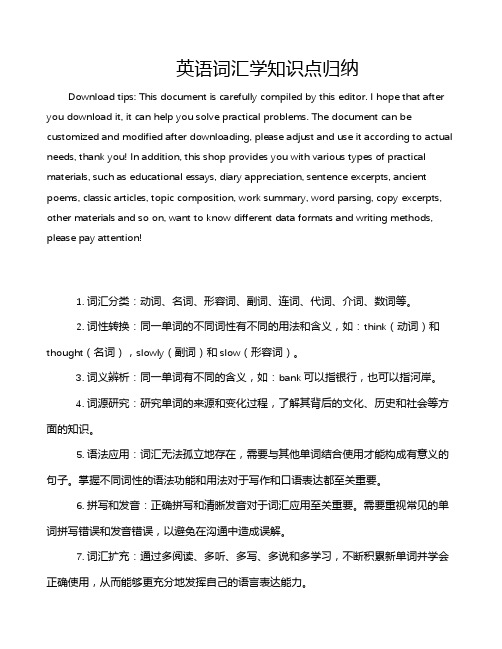
英语词汇学知识点归纳Download tips: This document is carefully compiled by this editor. I hope that after you download it, it can help you solve practical problems. The document can be customized and modified after downloading, please adjust and use it according to actual needs, thank you! In addition, this shop provides you with various types of practical materials, such as educational essays, diary appreciation, sentence excerpts, ancient poems, classic articles, topic composition, work summary, word parsing, copy excerpts, other materials and so on, want to know different data formats and writing methods, please pay attention!1. 词汇分类:动词、名词、形容词、副词、连词、代词、介词、数词等。
2. 词性转换:同一单词的不同词性有不同的用法和含义,如:think(动词)和thought(名词),slowly(副词)和slow(形容词)。
3. 词义辨析:同一单词有不同的含义,如:bank可以指银行,也可以指河岸。
4. 词源研究:研究单词的来源和变化过程,了解其背后的文化、历史和社会等方面的知识。
英语词汇学复习要点(不过就难啊)
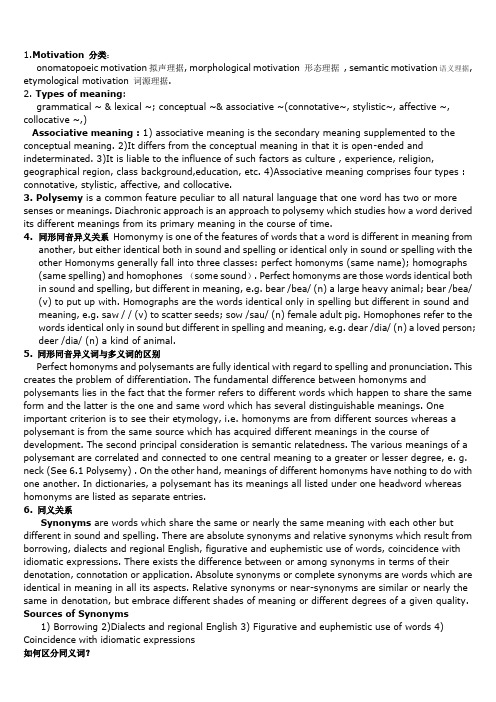
1.Motivation 分类:onomatopoeic motivation拟声理据, morphological motivation形态理据, semantic motivation语义理据, etymological motivation词源理据.2. Types of meaning:grammatical ~ & lexical ~; conceptual ~& associative ~(connotative~, stylistic~, affective ~, collocative ~,)Associative meaning : 1) associative meaning is the secondary meaning supplemented to the conceptual meaning. 2)It differs from the conceptual meaning in that it is open-ended and indeterminated. 3)It is liable to the influence of such factors as culture , experience, religion, geographical region, class background,education, etc. 4)Associative meaning comprises four types : connotative, stylistic, affective, and collocative.3. Polysemy is a common feature peculiar to all natural language that one word has two or more senses or meanings. Diachronic approach is an approach to polysemy which studies how a word derived its different meanings from its primary meaning in the course of time.4.同形同音异义关系Homonymy is one of the features of words that a word is different in meaning fromanother, but either identical both in sound and spelling or identical only in sound or spelling with the other Homonyms generally fall into three classes: perfect homonyms (same name); homographs (same spelling) and homophones (some sound). Perfect homonyms are those words identical both in sound and spelling, but different in meaning, e.g. bear /bea/ (n) a large heavy animal; bear /bea/ (v) to put up with. Homographs are the words identical only in spelling but different in sound and meaning, e.g. saw / / (v) to scatter seeds; sow /sau/ (n) female adult pig. Homophones refer to the words identical only in sound but different in spelling and meaning, e.g. dear /dia/ (n) a loved person;deer /dia/ (n) a kind of animal.5. 同形同音异义词与多义词的区别Perfect homonyms and polysemants are fully identical with regard to spelling and pronunciation. This creates the problem of differentiation. The fundamental difference between homonyms and polysemants lies in the fact that the former refers to different words which happen to share the same form and the latter is the one and same word which has several distinguishable meanings. One important criterion is to see their etymology, i.e. homonyms are from different sources whereas a polysemant is from the same source which has acquired different meanings in the course of development. The second principal consideration is semantic relatedness. The various meanings of a polysemant are correlated and connected to one central meaning to a greater or lesser degree, e. g. neck (See 6.1 Polysemy) . On the other hand, meanings of different homonyms have nothing to do with one another. In dictionaries, a polysemant has its meanings all listed under one headword whereas homonyms are listed as separate entries.6. 同义关系Synonyms are words which share the same or nearly the same meaning with each other but different in sound and spelling. There are absolute synonyms and relative synonyms which result from borrowing, dialects and regional English, figurative and euphemistic use of words, coincidence with idiomatic expressions. There exists the difference between or among synonyms in terms of their denotation, connotation or application. Absolute synonyms or complete synonyms are words which are identical in meaning in all its aspects. Relative synonyms or near-synonyms are similar or nearly the same in denotation, but embrace different shades of meaning or different degrees of a given quality. Sources of Synonyms1) Borrowing 2)Dialects and regional English 3) Figurative and euphemistic use of words 4) Coincidence with idiomatic expressions如何区分同义词?1Difference in denotation2 Difference in connotation 3 Difference in application7.What are the characteristics of antonyms?1) Antonyms are classified on the basis of semantic opposition 2) A word which has more than one meaning can have more than one antonym. 3) Antonyms differ in semantic inclusion. 4) Contrary terms are gradable antonyms, differing in degree of intenisty, so each has its own corresponding opposite.8.上下义关系:Hyponymy deals with the relationship of semantic inclusion. That is, the meaningof a more specific word is included in that of another more general word. Superordinates refer to some general words; subordinates denote those more specific words. Hyponymy can be described in terms of tree-like graphs, with higher-order superordinates above the lower subordinates. But their status either as superordinate or subordinate is relative to other terms. For example, horse, dog, pig are subordinates in relation to animal, but superordinates of mare, hound and boar, Animal itself becomes a subordinate of creature. And creature in turn becomes9.词义变化的种类There are five types of meaning, changes: extension, narrowing, degradation,elevation, and transfer among which extension and narrowing are the most common. Changes in meaning can be accounted for from extra-linguistic factors (historical reason, class reason, and psychological reason) and intra-linguistic factors (shortening, the influx of borrowing, and analogy).10.词义的扩大Extension is a process by which a word with a specialized sense is generalized to covera broader or less词义的缩小Narrowing is a process by which a word of wider meaning acquires a specialized sense;词义的升格Elevation is a process by which a word moves from a derogatory or neutral sense to a neutral and/or appreciative sense;词义的降格Degradation is a process by which a word of reputation slides into a pejorative use,;11.词义的转移Transfer is a process by which a word denoting one thing changes to refer to a differentbut related thing. Paper serves as an example. This word formerly denoted an African plant papyrus, which was once used to make paper. In modern times, paper is made from rags, wood, straw and the like, but the product has retained the same name. There is associated transfer. There are other kinds of transfer, such as, concrete to abstract, abstract to concrete and transfer of sensation. 12.语境的种类:非语言语境。
自考2英语词汇学考试重点精华整理

自考2英语词汇学考试重点精华整理一、词汇学概述1、语言与词汇的关系:语言是词汇和语法规则的总和,而词汇则是语言中最基本的元素。
2、词汇学的定义:词汇学是研究语言的词汇以及词汇的起源、演变、语义和语用等方面的学科。
3、词汇学的研究对象:主要包括词汇的起源、演变过程、语义变化、文化背景等。
二、英语词汇的历史演变1、英语的起源:英语起源于古代日耳曼语,经过长时间的演变和发展,形成了今天的英语。
2、英语词汇的演变:英语词汇经历了许多变化,包括词义的变化、词形的变化、外来词的引入等。
3、英语词汇的分类:英语词汇可以根据其来源、语义、语法等方面进行分类。
三、英语词汇的语义关系1、同义词与反义词:同义词是指具有相同或相似意义的词汇,而反义词则是指具有相反意义的词汇。
2、上下义词与下义词:上下义词是指在一个词汇的语义场中,一个词可以表示另一个词的上层概念或下层概念。
3、词汇的文化意义:词汇的文化意义是指词汇在特定文化背景中所具有的意义。
四、英语词汇的记忆与运用1、记忆策略:记忆策略是指通过一定的方法来提高记忆效率,包括联想记忆、语境记忆等。
2、运用技巧:运用技巧是指在使用词汇时需要注意的事项,包括语用、语法等方面。
3、常见错误分析:常见错误分析是指对学生在使用词汇时容易犯的错误进行分析和纠正。
五、英语词汇的学习方法与技巧1、学习策略:学习策略是指通过一定的方法来提高学习效率,包括制定学习计划、使用学习工具等。
2、学习技巧:学习技巧是指在学习过程中需要注意的事项,包括如何集中注意力、如何提高学习效率等。
3、学习资源:学习资源是指在学习过程中可以使用的各种资源,包括书籍、网站、课程等。
词汇学是语言学的一个分支,主要研究词汇的起源、发展、变化和用法。
它涉及对单词的音、形、义、语法特征和语用意义等方面的研究。
词汇学有一些基本概念,包括词、词汇、词素、词义、语境等。
词是语言中最小的、可以独立使用的意义单位,词汇是语言中所有词的总和,词素是构成词的要素,词义是词的含义,语境是指词所处的语言环境。
《英语词汇学》知识点归纳
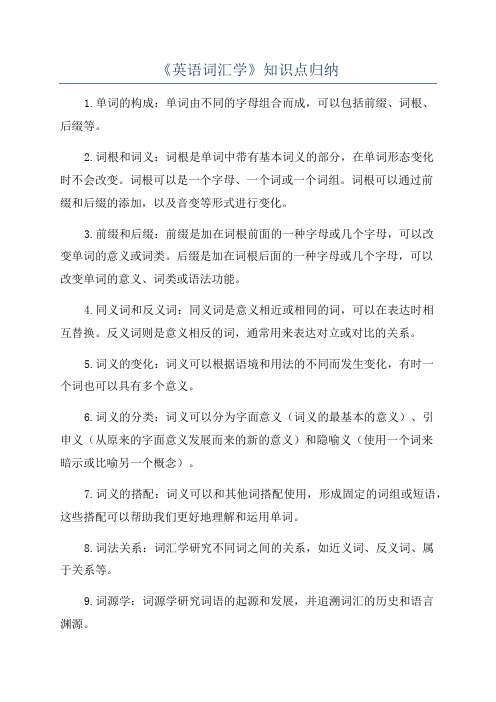
《英语词汇学》知识点归纳
1.单词的构成:单词由不同的字母组合而成,可以包括前缀、词根、
后缀等。
2.词根和词义:词根是单词中带有基本词义的部分,在单词形态变化
时不会改变。
词根可以是一个字母、一个词或一个词组。
词根可以通过前
缀和后缀的添加,以及音变等形式进行变化。
3.前缀和后缀:前缀是加在词根前面的一种字母或几个字母,可以改
变单词的意义或词类。
后缀是加在词根后面的一种字母或几个字母,可以
改变单词的意义、词类或语法功能。
4.同义词和反义词:同义词是意义相近或相同的词,可以在表达时相
互替换。
反义词则是意义相反的词,通常用来表达对立或对比的关系。
5.词义的变化:词义可以根据语境和用法的不同而发生变化,有时一
个词也可以具有多个意义。
6.词义的分类:词义可以分为字面意义(词义的最基本的意义)、引
申义(从原来的字面意义发展而来的新的意义)和隐喻义(使用一个词来
暗示或比喻另一个概念)。
7.词义的搭配:词义可以和其他词搭配使用,形成固定的词组或短语,这些搭配可以帮助我们更好地理解和运用单词。
8.词法关系:词汇学研究不同词之间的关系,如近义词、反义词、属
于关系等。
9.词源学:词源学研究词语的起源和发展,并追溯词汇的历史和语言
渊源。
10.词汇扩充:词汇学研究如何通过学习和运用词汇扩充词汇量,如学习词根、前缀和后缀的意义和用法,以及拆解和分析复杂单词的方法。
英语词汇学知识点归纳详细
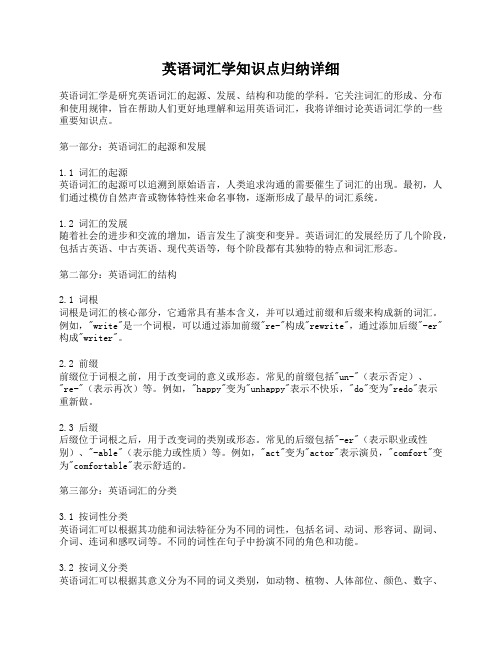
英语词汇学知识点归纳详细英语词汇学是研究英语词汇的起源、发展、结构和功能的学科。
它关注词汇的形成、分布和使用规律,旨在帮助人们更好地理解和运用英语词汇,我将详细讨论英语词汇学的一些重要知识点。
第一部分:英语词汇的起源和发展1.1 词汇的起源英语词汇的起源可以追溯到原始语言,人类追求沟通的需要催生了词汇的出现。
最初,人们通过模仿自然声音或物体特性来命名事物,逐渐形成了最早的词汇系统。
1.2 词汇的发展随着社会的进步和交流的增加,语言发生了演变和变异。
英语词汇的发展经历了几个阶段,包括古英语、中古英语、现代英语等,每个阶段都有其独特的特点和词汇形态。
第二部分:英语词汇的结构2.1 词根词根是词汇的核心部分,它通常具有基本含义,并可以通过前缀和后缀来构成新的词汇。
例如,"write"是一个词根,可以通过添加前缀"re-"构成"rewrite",通过添加后缀"-er"构成"writer"。
2.2 前缀前缀位于词根之前,用于改变词的意义或形态。
常见的前缀包括"un-"(表示否定)、"re-"(表示再次)等。
例如,"happy"变为"unhappy"表示不快乐,"do"变为"redo"表示重新做。
2.3 后缀后缀位于词根之后,用于改变词的类别或形态。
常见的后缀包括"-er"(表示职业或性别)、"-able"(表示能力或性质)等。
例如,"act"变为"actor"表示演员,"comfort"变为"comfortable"表示舒适的。
第三部分:英语词汇的分类3.1 按词性分类英语词汇可以根据其功能和词法特征分为不同的词性,包括名词、动词、形容词、副词、介词、连词和感叹词等。
词汇学期末复习各章知识点
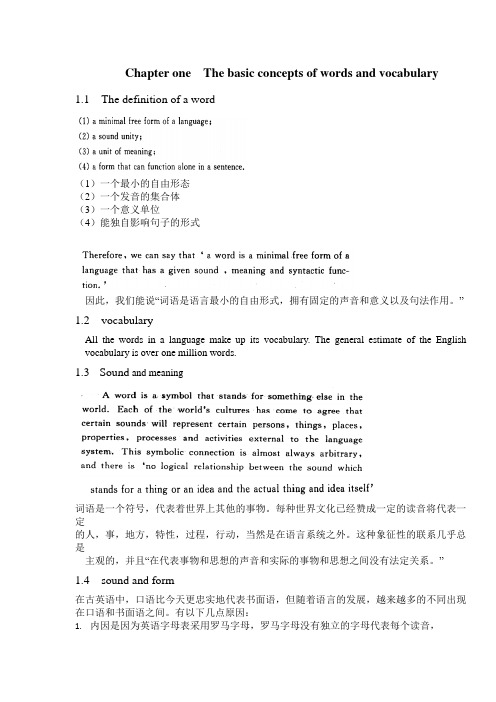
Chapter one The basic concepts of words and vocabulary1.1 The definition of a word(1)一个最小的自由形态(2)一个发音的集合体(3)一个意义单位(4)能独自影响句子的形式因此,我们能说“词语是语言最小的自由形式,拥有固定的声音和意义以及句法作用。
”1.2 vocabularyAll the words in a language make up its vocabulary. The general estimate of the English vocabulary is over one million words.1.3Sound and meaning词语是一个符号,代表着世界上其他的事物。
每种世界文化已经赞成一定的读音将代表一定的人,事,地方,特性,过程,行动,当然是在语言系统之外。
这种象征性的联系几乎总是主观的,并且“在代表事物和思想的声音和实际的事物和思想之间没有法定关系。
”1.4 sound and form在古英语中,口语比今天更忠实地代表书面语,但随着语言的发展,越来越多的不同出现在口语和书面语之间。
有以下几点原因:1.内因是因为英语字母表采用罗马字母,罗马字母没有独立的字母代表每个读音,因此一些字母代表两个读音或者组合在一起发音。
2.另一个原因是发音比拼写的变化快,在一些时候还拉开了距离。
在最近五百年里,尽管口语发音已经出现了显著的变化,却没有相应的拼写变化。
Another reason for this is that the pronunciation has changed more rapidly than spelling over the years, and in some cases the two have drawn far apart.3.第三个原因是一些早期的书写员发明了一些不同Those scribes had made some change to the word spelling4.到1500年年末,印刷已经变得非常普及。
英语词汇学复习重点——5、7-12单元
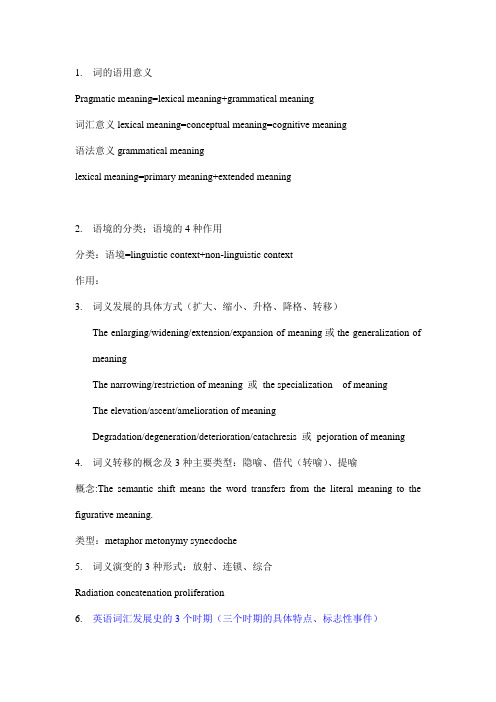
1.词的语用意义Pragmatic meaning=lexical meaning+grammatical meaning词汇意义lexical meaning=conceptual meaning=cognitive meaning语法意义grammatical meaninglexical meaning=primary meaning+extended meaning2.语境的分类;语境的4种作用分类:语境=linguistic context+non-linguistic context作用:3.词义发展的具体方式(扩大、缩小、升格、降格、转移)The enlarging/widening/extension/expansion of meaning或the generalization of meaningThe narrowing/restriction of meaning 或the specialization of meaningThe elevation/ascent/amelioration of meaningDegradation/degeneration/deterioration/catachresis 或pejoration of meaning 4.词义转移的概念及3种主要类型:隐喻、借代(转喻)、提喻概念:The semantic shift means the word transfers from the literal meaning to the figurative meaning.类型:metaphor metonymy synecdoche5.词义演变的3种形式:放射、连锁、综合Radiation concatenation proliferation6.英语词汇发展史的3个时期(三个时期的具体特点、标志性事件)The old EnglishThe middle EnglishThe modern English7.英语词汇的3种来源:本族语词、借词、新词Native words. loan/borrow words. Neologism8、新词的概念及4种产生方式(途径)新词(neologism&vogue words )A neologism is a recently coined word,phrase or usage.It can also be an existing word or phrase which has been assigned a new meaning.产生:1.构词法造词Word formation 2.借词borrowing 3.杜撰新词new coinage 4.语义转换semantic shift9、全世界使用英语国家的分类:ENL,ESL,EFLENL:English as a native languageESL:English as a second languageEFL:English as a foreign language10、美国英语词汇各发展阶段的特点(标志性事件)1.17世纪初到北美独立战争结束词美国在语言上的独立汇学家韦伯斯特美国独立战争后到内战占主导地位的仍然是英国英语美国内战后美国成为世界“盟主”对英语的影响不断扩大11、英语搭配的3种类别:固定型组合(成语/习语),自由型组合,习惯型搭配(能举例说明)固定型组合(fixed combination):see eye to eye(with)自由组合(free combination): see a film习惯型搭配(natural collocation): a cigar smoker12、搭配的4种理据语法(grammatical motivation)语用(pragmatic motivation)语义(semantic motivation)认知(cognitive motivation)13、英语成语的4个特点习用性:idiomaticity定型性:syntactic frozenness整体性:semantic nuity不透明性:semantic opacity14、英语成语的分类按句法分类:1.nominal idioms2.adjectival idioms3.verbal idioms 4.advertial idioms 5.sentence idioms最常见的按形式分类:1.比喻成语(figurative idioms)--隐喻成语(metaphorical idioms)明喻成语(similized idioms)2.谚语(proverbs)3.俚语(slang)。
- 1、下载文档前请自行甄别文档内容的完整性,平台不提供额外的编辑、内容补充、找答案等附加服务。
- 2、"仅部分预览"的文档,不可在线预览部分如存在完整性等问题,可反馈申请退款(可完整预览的文档不适用该条件!)。
- 3、如文档侵犯您的权益,请联系客服反馈,我们会尽快为您处理(人工客服工作时间:9:00-18:30)。
1.Motivation 分类:onomatopoeic motivation拟声理据, morphological motivation形态理据, semantic motivation语义理据, etymological motivation词源理据.2. Types of meaning:grammatical ~ & lexical ~; conceptual ~& associative ~(connotative~, stylistic~, affective ~, collocative ~,)Associative meaning : 1) associative meaning is the secondary meaning supplemented to the conceptual meaning. 2)It differs from the conceptual meaning in that it is open-ended and indeterminated. 3)It is liable to the influence of such factors as culture , experience, religion, geographical region, class background,education, etc. 4)Associative meaning comprises four types : connotative, stylistic, affective, and collocative.3. Polysemy is a common feature peculiar to all natural language that one word has two or more senses or meanings. Diachronic approach is an approach to polysemy which studies how a word derived its different meanings from its primary meaning in the course of time.4.同形同音异义关系Homonymy is one of the features of words that a word is different in meaning fromanother, but either identical both in sound and spelling or identical only in sound or spelling with the other Homonyms generally fall into three classes: perfect homonyms (same name); homographs (same spelling) and homophones (some sound). Perfect homonyms are those words identical both in sound and spelling, but different in meaning, e.g. bear /bea/ (n) a large heavy animal; bear /bea/ (v) to put up with. Homographs are the words identical only in spelling but different in sound and meaning, e.g. saw / / (v) to scatter seeds; sow /sau/ (n) female adult pig. Homophones refer to the words identical only in sound but different in spelling and meaning, e.g. dear /dia/ (n) a loved person;deer /dia/ (n) a kind of animal.5. 同形同音异义词与多义词的区别Perfect homonyms and polysemants are fully identical with regard to spelling and pronunciation. This creates the problem of differentiation. The fundamental difference between homonyms and polysemants lies in the fact that the former refers to different words which happen to share the same form and the latter is the one and same word which has several distinguishable meanings. One important criterion is to see their etymology, i.e. homonyms are from different sources whereas a polysemant is from the same source which has acquired different meanings in the course of development. The second principal consideration is semantic relatedness. The various meanings of a polysemant are correlated and connected to one central meaning to a greater or lesser degree, e. g. neck (See 6.1 Polysemy) . On the other hand, meanings of different homonyms have nothing to do with one another. In dictionaries, a polysemant has its meanings all listed under one headword whereas homonyms are listed as separate entries.6. 同义关系Synonyms are words which share the same or nearly the same meaning with each other but different in sound and spelling. There are absolute synonyms and relative synonyms which result from borrowing, dialects and regional English, figurative and euphemistic use of words, coincidence with idiomatic expressions. There exists the difference between or among synonyms in terms of their denotation, connotation or application. Absolute synonyms or complete synonyms are words which are identical in meaning in all its aspects. Relative synonyms or near-synonyms are similar or nearly the same in denotation, but embrace different shades of meaning or different degrees of a given quality. Sources of Synonyms1) Borrowing 2)Dialects and regional English 3) Figurative and euphemistic use of words 4) Coincidence with idiomatic expressions如何区分同义词?1Difference in denotation2 Difference in connotation 3 Difference in application7.What are the characteristics of antonyms?1) Antonyms are classified on the basis of semantic opposition 2) A word which has more than one meaning can have more than one antonym. 3) Antonyms differ in semantic inclusion. 4) Contrary terms are gradable antonyms, differing in degree of intenisty, so each has its own corresponding opposite.8.上下义关系:Hyponymy deals with the relationship of semantic inclusion. That is, the meaningof a more specific word is included in that of another more general word. Superordinates refer to some general words; subordinates denote those more specific words. Hyponymy can be described in terms of tree-like graphs, with higher-order superordinates above the lower subordinates. But their status either as superordinate or subordinate is relative to other terms. For example, horse, dog, pig are subordinates in relation to animal, but superordinates of mare, hound and boar, Animal itself becomes a subordinate of creature. And creature in turn becomes9.词义变化的种类There are five types of meaning, changes: extension, narrowing, degradation,elevation, and transfer among which extension and narrowing are the most common. Changes in meaning can be accounted for from extra-linguistic factors (historical reason, class reason, and psychological reason) and intra-linguistic factors (shortening, the influx of borrowing, and analogy).10.词义的扩大Extension is a process by which a word with a specialized sense is generalized to covera broader or less词义的缩小Narrowing is a process by which a word of wider meaning acquires a specialized sense;词义的升格Elevation is a process by which a word moves from a derogatory or neutral sense to a neutral and/or appreciative sense;词义的降格Degradation is a process by which a word of reputation slides into a pejorative use,;11.词义的转移Transfer is a process by which a word denoting one thing changes to refer to a differentbut related thing. Paper serves as an example. This word formerly denoted an African plant papyrus, which was once used to make paper. In modern times, paper is made from rags, wood, straw and the like, but the product has retained the same name. There is associated transfer. There are other kinds of transfer, such as, concrete to abstract, abstract to concrete and transfer of sensation. 12.语境的种类:非语言语境。
